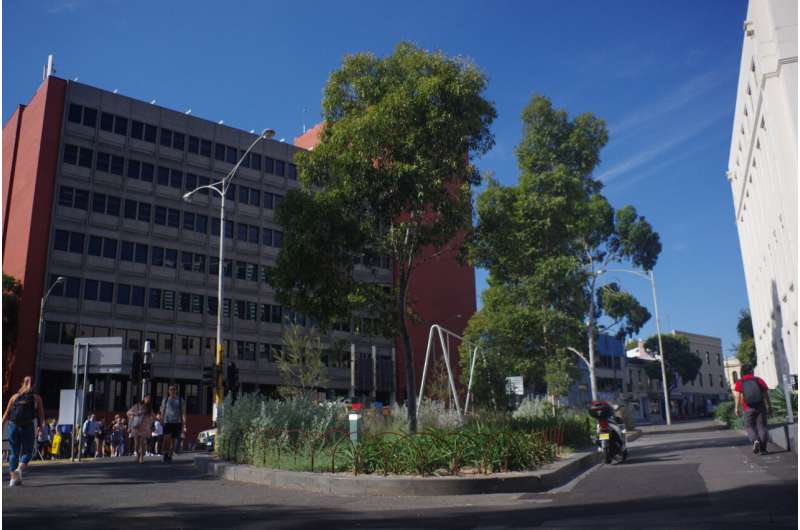This article has been reviewed according to Science X's editorial process and policies. Editors have highlighted the following attributes while ensuring the content's credibility:
fact-checked
trusted source
proofread
Small urban greening projects can dramatically increase number of insect species in cities

By increasing the diversity of indigenous plants in urban areas, researchers from the University of Melbourne have seen a seven-fold increase in the number of insect species in just three years, confirming the ecological benefits of urban greening projects. The findings are published in Ecological Solutions and Evidence.
The study, conducted in a small greenspace in the City of Melbourne, found that an increase in the diversity and complexity of plant communities leads to a large increase in insect biodiversity, a greater probability of attracting insects, and a higher number of ecological interactions between plants and insects.
Bringing nature into our cities has been shown to deliver a host of benefits, from well-being to increased biodiversity and climate change mitigation. Being able to quantify the benefits of greening projects like rooftop gardens or urban wildflower meadows has become a sharp focus for people creating and funding them.
However, prior to this study, there was little observed evidence of how specific greening actions might mitigate the detrimental effects of urbanization through boosting the numbers of indigenous insect species that have become rare or ceased to exist in a particular area.
Lead author of the study, Dr. Luis Mata of the School of Agriculture, Food and Ecosystem Sciences and Lead Research Scientist at Cesar Australia, explained, "Our findings provide crucial evidence that supports best practice in greenspace design and contributes to re-invigorate policies aimed at mitigating the negative impacts of urbanization on people and other species."
Prior to the beginning of the study in April 2016, the research team's chosen greenspace was limited in vegetation—simply a grass lawn and two trees. Across April, the site was substantially transformed through weeding, the addition of new topsoil, soil decompaction and fertilization, organic mulching, and the addition of 12 indigenous plant species.
Across the four-year length of the study, the researchers conducted 14 insect surveys using entomological nets to sample each plant species for ants, bees, wasps, beetles and more. Overall, 94 insect species were identified, 91 of which were indigenous to Victoria, Australia.
"Most importantly, the indigenous insect species we documented spanned a diverse array of functional groups: detritivores that recycle nutrients; herbivores that provide food for reptiles and birds; predators and parasitoids that keep pest species in check," added Dr. Mata.
After only one year, the 12 plant species planted at the beginning of the study were found to support an estimated 4.9 times more insect species than the original two species that had existed in the greenspace where the research took place. By the study's third year, only nine plant species remained, but still supported an estimated 7.3 times more insect species than the original species present in the greenspace.
"An increase in the diversity and complexity of the plant community led to—after only three years—a large increase in insect species richness, a greater probability of occurrence of insects within the greenspace, and a higher number and diversity of interactions between insects and plant species," continued Dr. Mata.
The research team's flexible approach to assessing the ecological benefits of urban greening can be adapted for use at multiple sites, during different seasons, or for longer durations of time, thus making it relevant for scientists and urban planners worldwide.
"I'd love to see many more urban greenspaces transformed into habitats for indigenous species," declared Dr. Mata. "We hope that our study will serve as a catalyst for a new way to demonstrate how urban greening may effect positive ecological changes."
More information: Large positive ecological changes of small urban greening actions, Ecological Solutions and Evidence (2023). DOI: 10.1002/2688-8319.12259
Provided by British Ecological Society




















